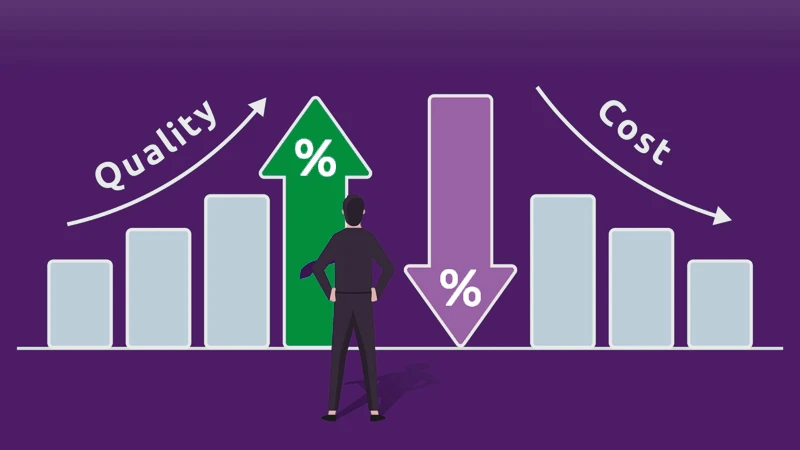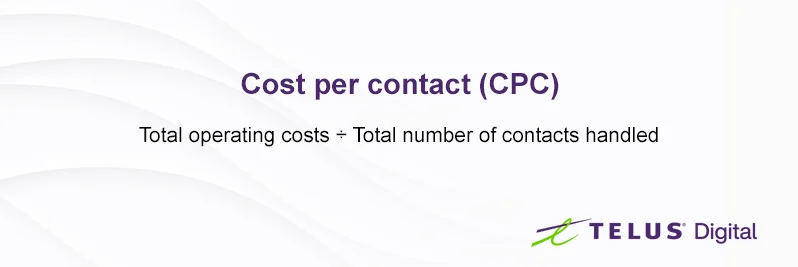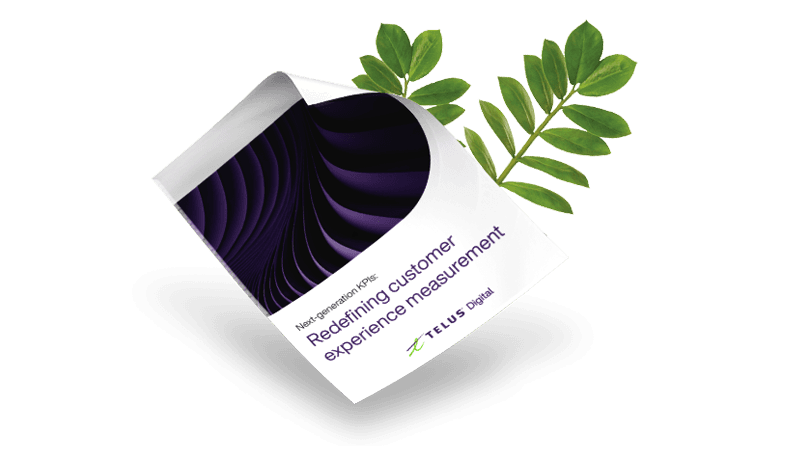
With growing channel complexity, rising customer expectations and mounting pressure to do more with less, contact centers are being asked to deliver both exceptional service and measurable efficiency.
To manage this balancing act, customer experience (CX) leaders are turning to cost per contact (CPC) — a key metric that helps quantify the cost of modern CX operations. But reducing it, without compromising experience, requires something more.
This is where AI is proving its value. From automating routine interactions to supporting live agents in real time, the use of AI in contact center environments is helping streamline operations, improve resolution speed and reduce costs, while maintaining the responsiveness and personalization customers expect.
What is cost per contact?
Unlike cost per call — which only tracks voice-based interactions — CPC offers a more complete and channel-agnostic view of operational efficiency. It reflects the average cost to resolve a customer inquiry via the contact method of their choice (e.g. chat, voice, social).
There is a popular assumption that CPC is strictly about wages, but it goes much deeper than that. It includes total operating costs, including infrastructure costs, technology licensing, training, overhead and the time required to resolve each issue.

CPC gives CX leaders insight into:
- The true cost of delivering customer support
- The relative cost of different contact types (e.g., chat vs. voice vs. email)
- The downstream impact of issues from other departments (like billing errors or outages)
While the formula is straightforward, the actual cost can vary significantly by channel. For instance, voice is often the most expensive due to longer handle times and higher infrastructure needs. Channels like chat or email tend to be more cost-effective, especially when agents can handle multiple conversations simultaneously.
What drives CPC up?
Several factors can contribute to rising CPC, including:
- High contact volumes: Often the result of repeat issues, poor self-service design or other factors such as product launches, promotional campaigns or seasonal spikes in demand
- Long average handle time (AHT): Caused by inefficient systems, slow knowledge retrieval or manual processes
- Low first contact resolution (FCR): When issues aren’t resolved the first time, customers return, increasing total contact cost
- Training and turnover costs: High attrition makes it expensive to ramp up new agents
- Channel fragmentation: Customers bounce between chat, voice and email without resolution, adding complexity and cost
Many organizations still rely on traditional cost-cutting measures to reduce CPC, such as trimming service hours, reducing staff or pushing aggressive call deflection. While these tactics may deliver short-term savings, they often come with trade-offs, including longer wait times, lower satisfaction and reduced agent capacity for handling complex issues.
AI offers an alternative. By introducing automation and intelligence into everyday operations, organizations can lower CPC in a more sustainable way. This approach improves efficiency without sacrificing customer experience.
How AI helps reduce CPC
Once viewed primarily as cost centers, contact centers are being reimagined as strategic drivers of efficiency and experience. This shift is accelerating investment in tools that can scale support without scaling costs.
Part of this transformation is the rise of agentic AI — autonomous, task-driven systems capable of reasoning, planning, decision-making and self-improvement. Unlike static bots or siloed tools, AI agents are intelligent collaborators that work across customer-facing and back-office functions to handle routine and time-consuming tasks with speed and accuracy.
As Steve Nemzer, director of AI growth and innovation at TELUS Digital, explained in the webinar, Are you ready for the era of agentic AI?, “These are AI systems that can do more than converse and solve abstract problems. They reason, they plan, they take actions that can separate a high-level goal into a series of logical substeps. They can gather information from their environment…analyze those inputs [and] self-critique their trajectory as they execute the sequence of steps. They can make decisions, course-correct and self-improve over time using chain of thought reasoning, and explain what they’re doing using conversational capabilities.”
Enterprise leaders are taking notice. According to PwC’s AI Agent Survey, 88% of executives plan to increase their AI-related budgets this year due to agentic AI, with over a quarter planning increases of 26% or more. And, more than half (57%) are actively using or planning to use AI agents in the next six months across functions like customer service.
AI delivers value across the contact center, from customer-facing interactions to backend operations. Whether assisting agents in real time, automating routine tasks or enabling more proactive, data-driven decisions, AI plays a critical role in streamlining workflows, improving service quality and ultimately reducing cost per contact.
Below are some of the most impactful ways AI is being applied in contact centers today, and how each one contributes to reducing cost per contact.
Chatbots and virtual assistants
AI agents for customer support are often the first point of contact for customers. These tools handle simple, repetitive inquiries like appointment scheduling, order status checks and password resets, and they can guide users to the right resources based on their needs.
Impact: Reduces overall contact volume by deflecting inquiries away from human agents.
Intelligent interactive voice response (IVR)
By using real-time data like sentiment, issue complexity and customer profile, these systems route inquiries to the most appropriate resource, whether human or AI.
Impact: Customers are matched with the right support faster, reducing AHT and minimizing costly misroutes or transfers.
Post-interaction automation
Tasks like sending confirmation emails, collecting feedback or tracking resolution status can be handled automatically, rather than consuming agent time.
Impact: Frees agents from routine administrative work, allowing them more time to focus on high-impact customer interactions.
Agent copilots
These tools offer contextual prompts, recommend next-best actions, correct tone and grammar, and automatically generate case summaries during live interactions.
The result: Improves agent performance by reducing AHT and increasing FCR.
The gains are well documented. A joint study by Stanford, MIT and the National Bureau of Economic Research found that access to AI assistance increased worker productivity by 15% on average, as measured by issues resolved per hour.
By enhancing speed, consistency and confidence, agent co-pilots help teams deliver more value in every interaction, without increasing headcount.
Sentiment analysis
By analyzing tone pace and word choice, AI can detect signs of frustration or dissatisfaction and trigger real-time escalation to a more experienced agent or supervisor when needed.
Impact: Helps prevent repeat contacts and reduces the risk of churn by enabling faster de-escalation.
Knowledge management
Surfaces the most relevant information at the right time, whether through self-service portals for customers or real-time prompts for agents. AI can also automate the capture of new knowledge from past interactions, tag and classify content for easier navigation and recommend updates to improve knowledge accuracy.
Impact: Shortens resolution time and reduces escalations, improving both AHT and FCR.
Predictive analysis
By analyzing behavioral data and historical trends, predictive analysis tools can anticipate customer needs and initiate preemptive actions, such as notifying a customer of a service outage or billing issue before they reach out.
Impact: Builds trust and reduces inbound volume by resolving issues before they occur.
Fraud detection
Uses machine learning to continuously analyze patterns across interactions, transactions and behaviors to identify anomalies that could indicate fraudulent activity. These systems can automatically flag or block suspicious behavior in real time, while maintaining a seamless experience for legitimate users.
Impact: Helps prevent fraud before it escalates, reducing loss, avoiding reputation damage and limiting the volume of inbound contacts related to fraud resolution or account recovery.
Workforce management
Analyzes real-time and historical data to forecast demand, optimize shift scheduling and balance workloads.
Impact: Improves staffing efficiency, reduces idle time and overtime, and lowers operational costs per contact.
Six common mistakes to avoid when using AI to reduce CPC
AI has the potential to significantly lower cost per contact, but only if implemented strategically. Rushing in with the wrong assumptions, or without a clear roadmap, can limit ROI and lead to missed opportunities. Below are some common pitfalls and how to avoid them.
1. Prioritizing cost savings over customer experience
It’s easy to view AI solely as a cost-saving tool, but the most effective deployments also improve the customer experience. When automation is tied to CX goals it leads to better outcomes and longer-term value. Efficiency should enhance satisfaction, not replace it.
2. Automating the wrong use cases
Not every interaction is a good candidate for automation. Start with high-volume, low-complexity tasks where automation can make a measurable impact quickly, such as password resets, order tracking and billing inquiries.
3. Assuming long calls are inefficient
Not all long calls are problematic. In many cases, they involve complex, high-value interactions like service renewals, financial verifications or technical troubleshooting. These contacts may take more time but can deliver strong business outcomes, including retention, upsell opportunities and increased customer trust. CX leaders should assess not just the duration of interactions, but their value and resolution quality.
4. Measuring success with incomplete metrics
While CPC is a valuable efficiency metric, it doesn’t tell the full story. Supporting metrics like average handle time and first contact resolution offer useful context, but they also have their own limitations. For example, focusing too heavily on lowering AHT can inadvertently pressure agents to prioritize speed over quality, potentially leading to unresolved issues, repeat contacts and lower customer satisfaction, all of which can drive CPC back up.
To get a fuller picture, CX leaders should track CPC alongside other KPIs like customer satisfaction (CSAT), Net Promoter Score (NPS) and agent engagement. Promisingly, this shift is already underway.

Next-generation KPIs: Redefining customer experience measurement
Customer experience (CX) is evolving — and your measurement strategy should too. Discover how next-generation KPIs can offer deeper insight into CX performance, from customer effort and journey satisfaction to agent engagement and digital maturity.
5. Reacting to short-term CPC fluctuations
Cost per contact is not a metric that should be evaluated daily. It fluctuates based on multiple variables, including staffing levels, channel mix, issue complexity and seasonal patterns. A sudden increase or drop doesn’t always reflect clear success or failure. Instead, CPC should be tracked monthly or quarterly to surface meaningful trends and inform long-term decisions.
6. Expecting lower volume to immediately lower costs
Reducing contact volume through automation or self-service is often a goal, but it doesn’t always lead to an immediate reduction in CPC. If fixed costs remain steady while volume drops, CPC may rise temporarily.
For example:
- $500,000 monthly support cost/100,000 contacts = $5.00 CPC
- $500,000 monthly support cost/80,000 contacts = $6.25 CPC
This doesn’t mean the strategy has failed. You may have successfully deflected low-value interactions, leaving your agents to handle more complex, high-impact work. Over time, additional efficiencies like reduced escalations or increased agent productivity will help bring CPC back down.
More efficient customer service starts with strategic AI
With AI, contact centers can do more than streamline operations. CX leaders can elevate the entire service experience, turning every interaction into a smarter, faster and more personalized exchange.
But unlocking those results takes more than simply adopting new technology. It requires clarity of purpose, well-chosen use cases and a plan for long-term scale. The organizations that succeed will not be the ones with the flashiest tools. They will be the ones that align AI investments with business goals and customer needs from the start.
This is where the right partner can accelerate progress. An experienced AI partner brings the strategic oversight needed to identify high-impact opportunities, guide implementation and help avoid costly missteps. AI is already transforming customer support. With the right approach and the right support it can also transform your bottom line. Ready to get started? Reach out to our team of experts.



